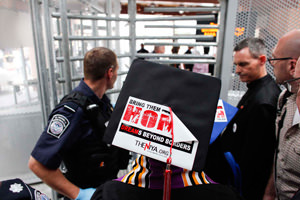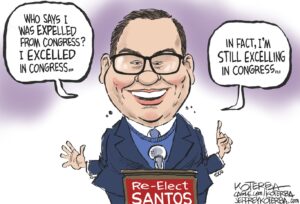Dreaming With Dignity
Undocumented students use a bold new strategy in their pursuit of documents, diplomas and immigration reform.
Thirty-four undocumented immigrants were detained at the Texas-Mexico border on Sept. 30. That fact by itself is unremarkable — thousands of immigrants are held in detention in the U.S. at any given time. What set this particular group of immigrants apart is that they showed up on the Mexico side of the border and openly proclaimed their desire to re-enter a country they consider home, without papers. By attempting to cross into the U.S. as part of a concerted campaign, they are forcing the U.S. immigration system to confront their humanity and create pathways for legalization.
This bold action, organized by the National Immigrant Youth Alliance (NIYA) under the banner of #BringThemHome, is the second chapter of a radical new way to draw attention to the struggles of undocumented immigrants — in particular young people who call themselves DREAM activists after the proposed DREAM Act. These youth were raised in the U.S. and most have graduated from high school or college, but now have few opportunities for a future because of their undocumented status.
The first chapter of NIYA’s challenge to the immigration system unfolded in August when nine young DREAMers presented themselves at Mexico’s border with Arizona. Three of them had voluntarily returned to Mexico; the rest were already there either from being deported or having gone to visit family members. The idea was that they would challenge border agents to deal with them under a spotlight rather than crossing the desert on foot.
Domenic Powell, a founding member of NIYA, explained to me in an interview, “We’ve noticed that when these things happen in the public eye, ICE [Immigration and Customs Enforcement] tends to move faster. They suddenly seem to find more humanitarian policies that they don’t seem to have access to on a regular basis.”
NIYA’s tactic has paid off. After the group got 43 members of Congress to sign letters to the Obama administration and gathered more than 27,000 signatures in an online petition, the DREAM 9, as they were dubbed, were all released after a little more than two weeks, on pending asylum requests.
Lisbeth Mateo is one of three immigrants among the DREAM 9 who voluntarily left the U.S. Her decision to return to Mexico and cross back into the states in order to begin the legalization process took serious courage because she and the others risked something even worse than simply being turned back from the border: prolonged or indefinite imprisonment in privately run U.S. detention centers that are largely closed to public scrutiny.
Eloy Detention Center in Arizona, where the DREAM 9 were held for 17 days, is owned by the private for-profit company Corrections Corporation of America. Mateo told me that detained immigrants she encountered on the inside revealed that the facilities had been cleaned the day before the DREAM 9 were brought in, likely in anticipation of their publicized action. “The conditions in the detention center are far different from what we saw. Before we arrived, they fixed the toilets. They fixed the things that were broken in those cells,” she said. Detainees told Mateo, “We didn’t have clean drinking water — the water was almost brown, the beds were really uncomfortable, the toilets were broken, the sinks were broken.”
The fact that immigrants in detention are treated as subhuman should come as no surprise. It is in fact a reflection of an openly hostile attitude from some segments of the American public toward immigrants.
For example, when Republican Rep. Steve King of Iowa was asked about the DREAM Act, he acknowledged that some of those young immigrants were certainly valedictorians. But then he went on to say, “For every one who’s a valedictorian, there’s another 100 out there that — they weigh 130 pounds, and they’ve got calves the size of cantaloupes because they’re hauling 75 pounds of marijuana across the desert.”
But NIYA’s success with the DREAM 9 has undermined those stereotypes and led to the second attempt to challenge the border on Sept. 30. What started out as a group of 30 undocumented people eventually increased to 34, all of whom either voluntarily returned to their countries of origin or were deported. Claudia Munoz, a core member of NIYA, spoke with me via cellphone from the Port of Entry at Laredo, Texas, while she waited on the U.S. side of the border to greet the immigrants an hour before the action. She explained that this new group, like the DREAM 9, “will literally get to the back of the line and attempt to cross in legally.”
Hours after I spoke with Munoz, the immigrants were taken into custody and detained. This larger group included a 4-year-old U.S. citizen and her undocumented mother, who were the first to be released from detention. As of this writing, eight of the group have been released and the rest have had interviews to determine their eligibility for asylum requests.
Munoz explained that after the DREAM 9 action, NIYA was inundated with calls from people who were desperate to return to their homes in the U.S. after being deported, or wanted deported family members to be able to return home. She explained: “One of the many things that the DREAM 9 action highlighted was the urgency for our community to be reunited. Thirty-four people compared to the 1.8 million people who have been deported is not that high a number. They just want to come back home and be with their families.”As immigrants know full well, the current system is set up against legal immigration. Immigrants, particularly from Mexico, even once they get through the complicated forms and shell out hundreds of dollars, have to wait a decade or more in order to be approved, if at all. Out of 1.4 million applicants from Mexico in 2011, only 26,000 were admitted because of visa caps. Powell challenged Obama officials to find a just solution. “If we really believe in family unity, if this administration believes in keeping families together, we should have a pathway for people to come home,” he said.
To date, the Obama administration has deported a record 1.8 million undocumented immigrants. Even though he has expressed strong support for the DREAM Act, and announced a policy last summer for young people to defer deportation, President Obama refuses to use his executive power to freeze deportations. Current immigration legislation, although extremely weak and filled with highly problematic sections such as enhanced border militarization, has stagnated in Congress.
According to Powell, the lives of undocumented immigrants “should not revolve around beltway politics and neither does our movement. We will continue to win victories for the immigrant community no matter what happens in D.C.”
Indeed Mateo, whose parents are undocumented and whose uncle was deported, participated in the DREAM 9 action for reasons both political and personal.
“We all have very different stories,” she said. “In my case for example, I had the chance to visit my family in Oaxaca. I was 14 when I moved to California so I do have some memories of living in Oaxaca. I have a grandfather in Mexico. I’ve lost a lot of family members over the years — I was not able to say goodbye to them. This time I was actually able to hug my grandpa and spend a couple of days with him.”
If NIYA continues to successfully enable immigrants to legally return home using this innovative tactic, it could create enough political pressure to make meaningful change. By openly attempting to return to a place they consider home, immigrants are challenging the notion that their humanity depends on a piece of paper.
Immigration authorities are in a bind: They can impose the heavy-handed practice of detention and deportation on these young immigrants and risk stoking public outrage, or they can quietly let them return to their homes, thereby creating a precedent for more such actions. Strategically speaking, it is a brilliant move, on par with the lunch counter sit-ins of the civil rights movement that challenged Jim Crow segregation, or the Freedom Flotillas of the Free Gaza movement, which just a few years ago attempted to undermine the Israeli siege of Gaza.
Mateo explained, “We’ve hopefully set a precedent for other families, for other DREAMers to come home. No matter where you are, you should be able to be with your family. There is no way a family should be separated.” She added, “The U.S. is my home and this is the place where I feel safe and I can be myself.”
In the absence of legislative progress, DREAM activists like Lisbeth Mateo have taken matters into their own hands and charted a way to simultaneously challenge a broken system while creating a tenuous route home for people, even if it is just a few at a time.
Mateo is finally realizing her dream: Just days after she was released from Eloy Detention Center, she began her first semester at Santa Clara University School of Law in Northern California. Like other DREAMers, her home and her future is here and now.
Your support matters…Independent journalism is under threat and overshadowed by heavily funded mainstream media.
You can help level the playing field. Become a member.
Your tax-deductible contribution keeps us digging beneath the headlines to give you thought-provoking, investigative reporting and analysis that unearths what's really happening- without compromise.
Give today to support our courageous, independent journalists.









You need to be a supporter to comment.
There are currently no responses to this article.
Be the first to respond.